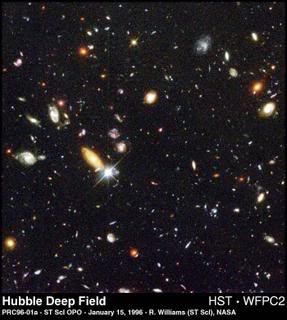
Galaxies. Trillions of them. With trillions of stars. Whoa.
If humans manage to escape Earth before the Sun turns into a Red Giant and boils away the planet's atmosphere, we'll have another astrological obstacle to overcome:
The collision of the Milky Way and Andromeda galaxies.
Sure, it will take a few billion years, but it's inevitable -- the gravity of the two galaxies is pushing them toward each other at a rate of several hundred kilometers per second. Eventually, they will collide, and the combined gravity will scatter their stars into new galactical formations. Our night skies would be forever changed - if, somehow, we're still around to observe it.
The Andromeda Galaxy is visible to the naked eye. We see it as it was 2.5 million years ago, since it's 2.5 million light years away, and its light takes 2.5 million years to travel to Earth.
With the proper equipment (i.e, deep space telescopes such as Hubble), we can see galaxies as far as 13 billion light years away. These galaxies are almost as old as the Universe itself, and predate the existence of Earth. So, when we look at pictures of these galaxies, we're viewing space as it was before the Earth even existed!
Consider, for a second, the distance implied by 13 billion light years. A light year is the distance light can travel through a vacuum in one year -- 5,878,625,373,183.61 miles. Multiply that by 13 billion . . . my calculator broke.

No comments:
Post a Comment